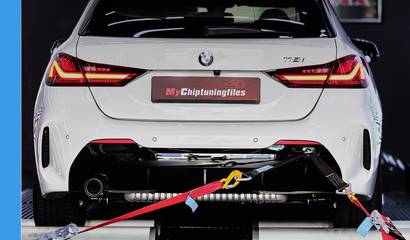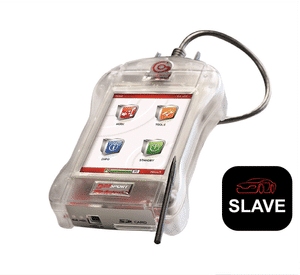Sunday 16 November

So, you’re getting into the world of car tuning, or maybe you’ve just heard the terms "chip tuning," "ECU remapping," and "flash tuning" thrown around. You’re probably wondering, “What do all these things mean, and how do they affect my car?” It’s an exciting area for car enthusiasts, but it can also be confusing if you’re new to it. Let’s break down each method and give you a comprehensive understanding of what sets them apart.
What Is Car Tuning?
Before we get to the specifics of chip tuning, ECU remapping, and flash tuning, let's clarify what "car tuning" means. Essentially, car tuning involves adjusting your vehicle’s Engine Control Unit (ECU), which is the “brain” of your car. The ECU controls a variety of systems in your engine, such as fuel efficiency, ignition timing, throttle response, and even boost pressure if you have a turbocharged engine.
Tuning your car allows you to tweak these settings to improve performance, efficiency, and responsiveness. Now, why would you want to tune your car? Well, the main reason is that factory settings are designed to be safe for a wide range of conditions. That means there’s typically some untapped potential in your engine’s performance. Tuning can unleash that potential by optimizing the settings for your driving habits, the kind of fuel you use, and your car’s specific needs.
Now, let’s break down the most common methods of tuning: chip tuning, ECU remapping, and flash tuning.
Chip Tuning: The Old-School Classic
Let’s kick things off with chip tuning, which is the OG method for tweaking your car’s performance. Back in the day—especially before the 1990s—many car manufacturers used physical chips to store and control engine data. This meant that if you wanted to alter the performance of your vehicle, you had to physically remove the chip, replace it with a modified one, and then install it back into the ECU.
Today, chip tuning is mostly obsolete, except for older vehicles or cars that haven’t been fitted with newer, reprogrammable ECUs. In chip tuning, you'd have to remove the chip, get a modified one (either purchased or custom-made), and solder it into the ECU. It’s quite a bit more invasive than other methods, and if not done properly, it could damage the ECU, which is an expensive repair.
While chip tuning might sound a bit old-fashioned compared to more modern methods, it has one significant advantage—it’s permanent. Once the new chip is installed, you don’t need to worry about any updates or flashing. It stays with your car until you decide to change it out.
Advantages of Chip Tuning:
- Permanent Change: Once the new chip is installed, it’s good to go.
- Effective for Older Cars: Some older vehicles still use non-reprogrammable ECUs, making chip tuning the only viable option.
- Increased Performance: When done properly, chip tuning can give your car a serious power boost.
Disadvantages:
- Risk of Damage: Improper installation can damage the ECU.
- No Reversal: Unlike some other tuning methods, chip tuning isn't easily reversible. If you want to undo it, you'd have to remove the chip and install a stock one again.
- Labor-Intensive: It requires physical work—removing and reinstalling the chip—so it’s not as user-friendly as modern methods.
ECU Remapping: The More Common Method
Today, ECU remapping is one of the most popular tuning methods. It involves altering the software that controls your car's engine. Instead of physically changing chips, ECU remapping updates the code inside your ECU, optimizing it for better performance.
With ECU remapping, you can make a variety of adjustments, such as increasing fuel efficiency, improving throttle response, or boosting horsepower and torque. In fact, many performance tuners prefer ECU remapping because it allows for much more flexibility than chip tuning.
You can either use an OBD2 port connection to remap the ECU, or in more advanced cases, the ECU may need to be removed from the vehicle and accessed directly (this is often referred to as bench remapping).
How Does ECU Remapping Work?
With ECU remapping, the process usually involves:
- Reading the Existing ECU Data: A technician will first extract the factory settings from your vehicle’s ECU.
- Modifying the Data: Using specialized software, the technician tweaks settings like air/fuel ratios, ignition timing, and turbo boost (if applicable).
- Uploading the New Map: Once the changes are made, the new data is written back into the ECU.
ECU remapping can result in significant power increases—especially in turbocharged vehicles. But it also allows for optimization of other factors, like driving comfort and fuel efficiency.
Advantages of ECU Remapping:
- Customizable: Unlike chip tuning, which replaces the entire chip, ECU remapping allows for fine-tuning of various parameters.
- Reversible: If you need to undo the tune for any reason (say, if you’re returning your car to stock for a warranty claim), it’s possible to flash the ECU back to its original settings.
- Tuning for Specific Needs: You can tune for power, fuel economy, or even throttle response, depending on your needs.
Disadvantages:
- Need for a Professional: It’s highly recommended that you have a professional carry out the remap, especially if you're new to tuning.
- Can Be Locked: Some newer ECUs are “locked,” meaning they can’t be remapped using standard methods. In such cases, you might need to remove the ECU entirely and access it directly.
Also Read: The Benefits of Stage 1, Stage 2 & Stage 3 Tuning for Your Car
Flash Tuning: Quick and Convenient
Now, let’s talk about flash tuning. This method is the easiest to understand and probably the most convenient for the average car enthusiast. Flash tuning is essentially a type of ECU remapping, but the key difference is that it’s done through a handheld device that plugs into your car’s OBD2 port. The most common devices for this are brands like Cobb, RaceChip, or even some mobile apps.
Flash tuning devices allow car owners to install a tune without needing to go to a specialist. These devices often come with preloaded tunes that you can select based on your needs, such as improving fuel efficiency, adding more power, or optimizing for specific driving conditions (like city driving versus highway driving). Some devices even allow you to switch between different tunes on the fly, so if you're in a situation where you need a more fuel-efficient mode, you can switch to it in seconds.
The great thing about flash tuning is that it’s super user-friendly. All you have to do is plug in the device, follow the instructions, and voila—you’ve got a tuned car.
Advantages of Flash Tuning:
- Convenience: You can tune your car yourself, anytime, without visiting a shop.
- Multiple Tunes: Many flash tuners let you store and switch between several tunes, so you can adjust the car’s performance based on your needs.
- Quick and Easy: The process is relatively straightforward and doesn’t require much technical knowledge.
Disadvantages:
- Less Customization: While there are several pre-loaded tunes, they’re not as customized as a professional ECU remap.
- Limited Adjustments: You might not have as much control over fine-tuning different aspects of the engine like a professional remap would allow.
How Are These Methods Different?
It’s easy to get confused because all of these methods modify your car’s ECU. But here’s a quick comparison:
Method | Hardware Required | Skill Level | Customization | Risk |
Chip Tuning | ECU opened + soldering | High | Medium | High |
ECU Remapping | Laptop + software | Medium | High | Medium |
Flash Tuning | Handheld device | Low | Low-Medium | Low |
Recap of Key Differences:
- Chip Tuning: Replaces the physical chip inside the ECU with a modified one. Very old-school and riskier, but permanent.
- ECU Remapping: Modifies the ECU’s software to optimize engine performance. It’s more flexible and customizable, and usually, it’s reversible.
- Flash Tuning: The most convenient and user-friendly, but typically involves using pre-loaded tunes that are not as customizable.
Also Read: Stage 1, Stage 2, and Stage 3 Tuning: Which One Is Right for You?
Is Tuning Safe?
A common concern for people considering tuning is whether it’s safe for the car. Well, the answer depends on a few factors. If done correctly, tuning is generally safe. Modern engines are designed to handle changes in their tuning parameters. However, it’s crucial to make sure that the tuning is done by a professional who understands your car’s specific needs and limits.
Improper tuning can lead to engine damage, poor performance, and potentially void your warranty. For example, adding too much boost to a turbocharged engine without upgrading the supporting components (like the intercooler) can result in overheating or even catastrophic engine failure.
Turn Your Passion into a Business: Start a Chiptuning Business with MyChiptuningfiles
If you’ve been thinking about how to start a chiptuning business, MyChiptuningfiles is the partner you can trust. We make it easier for professionals and newcomers alike to step into the world of ECU tuning without needing advanced technical skills.
Our tuning files are created by experts using trusted tools like WinOLS. Every file is carefully tested to ensure performance gains are both powerful and safe. Whether your clients want more horsepower, smoother driving, or better fuel economy, our files are built to deliver results that make a real difference.
You don’t need to be an expert tuner to get started. Just upload the original ECU file to our platform and receive a customized tuning file, ready to install. It's that simple. We also offer quick response times and dependable support, so you’re never left figuring things out alone.
With MyChiptuningfiles, you can start small and grow fast—without sacrificing quality. Offer your customers top-level tuning services while building a business that fits your goals.
Let’s help you take the first step. Start a chiptuning business today with MyChiptuningfiles and bring high-performance tuning to your clients with confidence.
Final Thoughts
When it comes down to it, chip tuning, ECU remapping, and flash tuning all serve the same purpose: improving the performance of your car. Whether you choose to use a professional ECU remap, a flash tuner for DIY tuning, or chip tuning for older vehicles, each method has its pros and cons.
For most people with newer cars, ECU remapping is the most popular and effective method. Flash tuning offers convenience for those looking for an easy way to tweak their car’s performance, and chip tuning, though outdated, is still a great option for older cars with non-programmable ECUs.
Tuning is one of the best ways to get more out of your car, but remember to always be cautious. Go to a professional, choose a reputable tuner, and don’t go too wild without upgrading the necessary hardware to support the added power. A well-executed tune can give your car a new lease on life—more power, better throttle response, and even improved fuel efficiency.
And don’t forget: always enjoy the ride!
news.related_news
Chiptuning tools
Whether you own a car, truck or tractor: we have the best equipment and software for tuning your petrol and diesel engine. With our chiptuning tools it is possible to easily read out the original engine software of your vehicle and upload it to our website. And then it's up to us to provide you with high-quality and customized chip tuning files. Curious about our range of chiptuning tools? Check it out via the button below!









